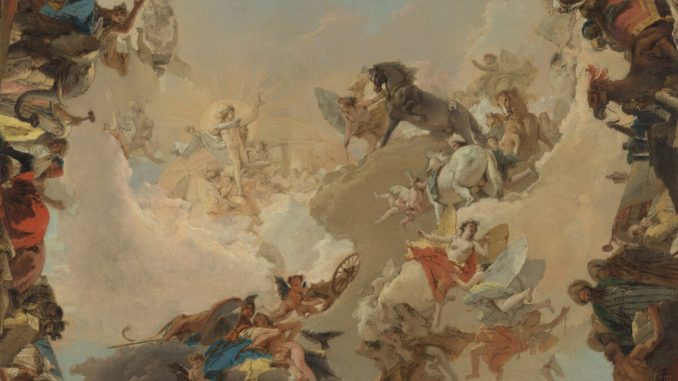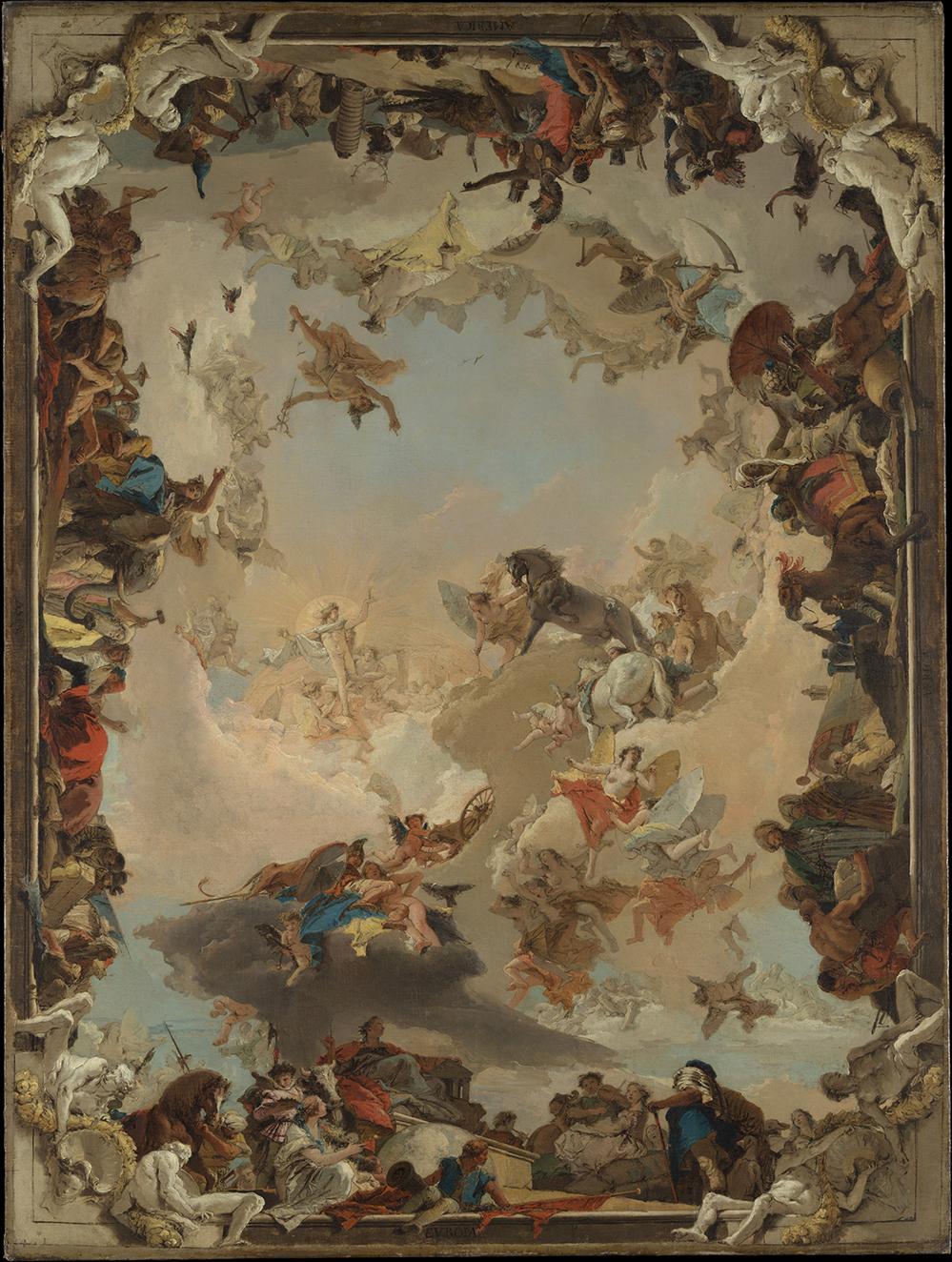
The Eye of the Beholder: Reflecting on the Purpose of Beauty and Art
We’ve all heard the phrase “Beauty is in the eye of the beholder,” but what does this mean and does it hold weight? In this series, we’ll take a casual look at the philosophical debates concerning our experiences with beauty and art. Through questions and reflection, we hope to gain a deeper understanding of beauty and art and their place in our lives.

In 1752, the Italian artist, Giovanni Tiepolo, produced a sketch for the staircase ceiling of Carl Philipp von Greiffenklau, prince-bishop of Würzburg. Tiepolo called this work of art, “Allegory of the Planets and Continents,” and it revealed his ambitious plans for the prince-bishop’s ceiling.

The sketch depicts Apollo, Greco-Roman god of the sun, music and poetry, order and beauty. Apollo is shown in the heavens to the left of the composition, and he is about to begin his daily journey carrying the sun on his chariot. He can be seen in the distance, the brilliance of the sun like a halo behind his head and torso.
The gods around Apollo also correspond to the movement of the celestial bodies. To the bottom left are Mars and Venus. When together, Venus, goddess of beauty, distracts Mars, god of war, with her beauty, and there is peace as a result.
Mercury, mostly known for being god of messages and communication, is to the top left. To the right of Mercury are Jupiter, god of the sky and thunder, and Saturn, the god associated with time.
Tiepolo framed his depiction of the heavens with clusters of high-contrast figures that compositionally appear closer to us. The four sides that frame the composition represent the excellence of the four continents known at that time: Europe, Africa, Asia, and America.
At first glance, this sketch simply reveals an imaginative scene in which the heavens and earth coexist; the gods take their course throughout the sky, and humans live out the stories that come to compose history.
Upon closer inspection, however, this sketch, in relation to Plato’s “Phaedrus,” opens up a broader discussion on aesthetics and beauty.
Socrates and Phaedrus
In Plato’s “Phaedrus,” Phaedrus convinces Socrates to leave the city of Athens, something Socrates never does, to hear a speech on love. Socrates agrees and follows Phaedrus into the countryside to listen to the clever speech.
After listening to Phaedrus recite the speech in his possession, Socrates—claiming to be overcome and inspired by the gods—criticizes Phaedrus’s speech and produces his own speech, one that questions the irrationality of love.
But his criticism of love does not sit well with him, and Socrates produces a third speech celebrating love as something divine, and parts of this speech will be the focus here.
Socrates’s third speech is summed up as follows:
The gods ride their chariots to the edge of heaven “where its circular motion carries them around as they stand while they gaze upon what is outside heaven.” What they witness outside of heaven nourishes them, and the circular motion brings them back to where they started.
On the way, they view Justice, Self-Control, and Knowledge as they are absolutely, and they drink ambrosia before resting. This is the life of the gods.
Souls are immortal and live as if they are pulled by a chariot that has two horses: one rational and one irrational. In heaven, these souls attempt to follow the gods as closely as possible. Only those who make themselves most like the god they follow will be successful.
The other souls are unable to control and balance the horses that guide their chariot; they fall behind the gods and are unable to see the truth of things. Unable to gaze upon the truth, the souls are overcome with forgetfulness; they shed their wings and fall to earth.
The souls incarnate on earth into animals or humans. Living a human life with injustice will reap the soul a bad fate, but living life with justice will reap a good fate and may potentially help the soul replenish its wings.
And here is where beauty comes in: here, on earth, the soul sees the divine in the truly beautiful. Beauty on Earth helps the soul remember the god it followed in heaven; beauty on Earth helps the soul remember the divine path it once took, and such beauty inspires divine love. Here, the memory of heaven is the standard for beauty.
Witnessing this beauty, the soul stands outside of human concerns, and Socrates calls this “madness.” He says,
“Now this takes me to the whole point of my discussion of the fourth kind of madness—that which someone shows when he sees the beauty we have down here and is reminded of true beauty; then he takes wing and flutters in his eagerness to rise up, but is unable to do so; and he gazes aloft, like a bird, paying no attention to what is down below—and that is what brings on him the charge that he has gone mad.”
Unfortunately, though all souls have witnessed a certain level of truth, not all souls are able to be reminded of this truth by way of beauty:
“But not every soul is easily reminded of the reality there by what it finds here—not souls that got only a brief glance at the reality there, not souls who had such bad luck when they fell down here that they were twisted by bad company into lives of injustice so that they forgot the sacred objects they had seen before.”
From this point of view, beauty in an absolute sense is inseparable from justice, which for Socrates is morality. In other words, for Socrates, morality is a necessary precursor to experiencing divine beauty, the type of beauty that overwhelms the human soul making it care more for its memory of heaven than for the world it now occupies.
Even in heaven, the souls that see the most of the reality there are the souls that are most like the god they follow. The souls that fall behind are least like the god they follow, which suggests that they are immoral in terms of the standard for that god.
Beauty That Points to the Divine
Returning to Tiepolo’s painting, the people of earth—all races, cultures, ethnicities, and so on—are depicted below the heavens, adorned with cultural elements that make them identifiable.
The gods above represent the movement of the planets and stars in the sky, as well as light, beauty, order, communication, love, war, and time.
The humans below are unable to escape what the gods above represent. We are all confined to this small planet that is suspended in a space and time that appears to us to be infinite; we are unable to exist absent from the concepts represented by the gods.
The cultures found across all of the continents have placed importance on the sky’s movement, to the light of the sun and the illumination of wisdom, to communicating tradition, to the joys of love and the woes of war, all under the banner of a movement we call time. Tiepolo’s painting can “remind” us of this.
Socrates suggests that beauty can remind us of heavenly truth. This suggests that culture can be divinely inspired if the arts of each culture attempt to shock the soul into remembering the sights it saw in heaven, which requires that artists contemplate the heavens and what it means to make divinely inspired objects for their respective culture.
According to Socrates, if such objects are able to make souls remember heaven, the souls will be overcome with the madness of divine love and potentially regain their wings.
Postmodern thought has attempted to deconstruct this absolute view of beauty. How can the beauty of Europe be absolute for the beauty of Africa? How can the beauty of the Americas be absolute for the beauty of China? Admittedly, the enforcement of absolutes across cultures often leads to problems.
But this doesn’t mean that each culture doesn’t have a heavenly standard with which they can identify. The history of cultures around the world suggests that each has, at one point or another, a golden age that corresponds with an understanding of divinity.
Does Socrates’s exposition of divine beauty offer us a way to create beautiful and sacred objects that inspire divine love? Or do his ideas of absolute beauty, truth, and justice inevitably lead to one culture attempting to dominate another with its absolutes?
Eric Bess is a practicing representational artist and is a doctoral candidate at the Institute for Doctoral Studies in the Visual Arts (IDSVA).





Be the first to comment